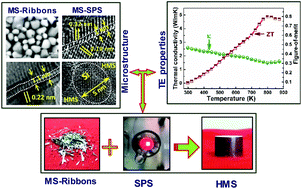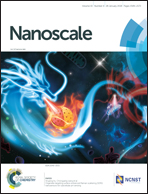Significant enhancement in thermoelectric performance of nanostructured higher manganese silicides synthesized employing a melt spinning technique†
Abstract
The limited thermoelectric performance of p-type Higher Manganese Silicides (HMS) in terms of their low figure-of-merit (ZT), which is far below unity, is the main bottle-neck for realising an efficient HMS based thermoelectric generator, which has been recognized as the most promising material for harnessing waste-heat in the mid-temperature range, owing to its thermal stability, earth-abundant and environmentally friendly nature of its constituent elements. We report a significant enhancement in the thermoelectric performance of nanostructured HMS synthesized using rapid solidification by optimizing the cooling rates during melt-spinning followed by spark plasma sintering of the resulting melt-spun ribbons. By employing this experimental strategy, an unprecedented ZT ∼ 0.82 at 800 K was realized in spark plasma sintered 5 at% Al-doped MnSi1.73 HMS, melt spun at an optimized high cooling rate of ∼2 × 107 K s−1. This enhancement in ZT represents a ∼25% increase over the best reported values thus far for HMS and primarily originates from a nano-crystalline microstructure consisting of a HMS matrix (20–40 nm) with excess Si (3–9 nm) uniformly distributed in it. This nanostructure, resulting from the high cooling rates employed during the melt-spinning of HMS, introduces a high density of nano-crystallite boundaries in a wide spectrum of nano-scale dimensions, which scatter the low-to-mid-wavelength heat-carrying phonons. This abundant phonon scattering results in a significantly reduced thermal conductivity of ∼1.5 W m−1 K−1 at 800 K, which primarily contributes to the enhancement in ZT.



 Please wait while we load your content...
Please wait while we load your content...